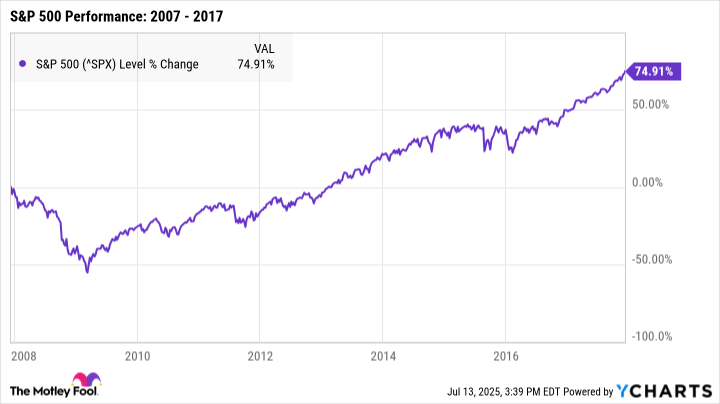Should You Buy ETFs at All-Time Highs? Here's What History Says
-
Stocks are reaching record highs, which has left many investors with mixed feelings.
-
No matter what may lie ahead for the market, history has good news for investors.
-
With the right strategy, you can protect your portfolio while setting yourself up for long-term gains.
The stock market has been reaching new heights in recent weeks. Since their low points in early April, the S&P 500 (^GSPC -0.40%) and Nasdaq Composite (^IXIC 0.18%) have surged by around 26% and 35%, respectively, as of this writing.
While the market may seem unstoppable right now, investing at record highs can carry a couple of risks. For one, it's a costly time to buy, as many stocks and exchange-traded funds (ETFs) are at their highest prices ever. Second, if a downturn is looming, there's a chance your portfolio could immediately drop in value if you buy now.
So what does history say about investing in ETFs at peak prices? There's very good news for investors -- plus some tried-and-true tactics to protect your money.

Image source: Getty Images.
History says the future is bright for the stock market
The stock market has faced a roller coaster of ups and downs over the last few decades. If there's one takeaway from history, though, it's that there's no such thing as a bad time to invest -- as long as you keep a long-term outlook.
Even if the market takes a turn for the worse, you won't actually lose any money unless you sell your investments. Your portfolio might lose value if stock prices fall, but the only way to lock in those losses is to sell your shares for less than you paid for them.
For example, let's look at investing during the Great Recession. Say you had invested in an S&P 500 ETF in December 2007 immediately before the market fell into a deep recession that would last until mid-2009.
In the short term, your investment would have immediately plummeted in value. But if you'd simply stayed in the market through all the turbulence, you'd have earned total returns of close to 75% over 10 years.

^SPX data by YCharts.
Historically, a long-term investing strategy is all but guaranteed to protect your portfolio. According to data from investment firm Capital Group, the S&P 500 has seen negative total returns in 33% of one-year periods throughout history. But over the last 82 years, there's never been a single 10-year period in which the index experienced negative total returns.
In other words, by holding an S&P 500 ETF for just one year and then selling, there's a good chance you'll lose money. But if you hold it for at least 10 years, you're extremely likely to see positive total returns.
Simple ways to prepare your portfolio
The uncertainty of the market right now can make it daunting to invest. Stock prices could continue soaring like they have the last couple of months, or they could take a turn -- especially if new tariff policies or other changes threaten economic stability.
However, there are a few simple steps that can prepare your portfolio for whatever may be on the horizon.
- Ignore short-term fluctuations: It's often easier said than done, but sometimes it's best to ignore what the market is doing on a day-to-day basis. Even in strong economic times, the market will experience routine dips. But the market's long-term track record is far more important than its short-term ups and downs.
- Build a solid emergency fund: Selling your investments after they've dropped in price can lock in steep losses, so it's wise to have at least some extra cash in a separate emergency fund. If the market takes a turn and you face an unplanned expense, it will be easier to cover it without touching your investment portfolio.
- Invest in the right places: Healthy companies with strong foundations are far more likely to survive market downturns, and the more of these stocks you have in your portfolio, the better off you'll be. When in doubt, an S&P 500 ETF -- such as the Vanguard S&P 500 ETF (VOO -0.34%) or iShares Core S&P 500 ETF Trust (IVV -0.44%) -- is one of the safest funds out there for surviving volatility.
Nobody knows whether stock prices will climb higher or take a fall in the coming months. But history shows that as long as you're willing to keep your money in the market for at least a few years, there's never necessarily a bad time to invest. By investing in the right places now, you'll be more prepared for whatever may be coming.
Disclaimer: Investing carries risk. This is not financial advice. The above content should not be regarded as an offer, recommendation, or solicitation on acquiring or disposing of any financial products, any associated discussions, comments, or posts by author or other users should not be considered as such either. It is solely for general information purpose only, which does not consider your own investment objectives, financial situations or needs. TTM assumes no responsibility or warranty for the accuracy and completeness of the information, investors should do their own research and may seek professional advice before investing.
Most Discussed
- 1
- 2
- 3
- 4
- 5
- 6
- 7
- 8
- 9
- 10